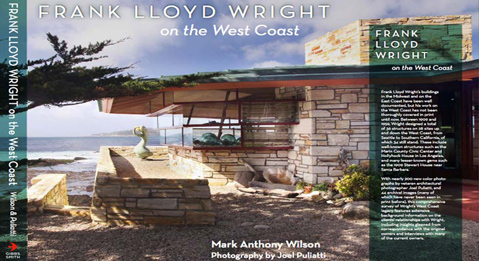Frank Lloyd Wright on the West Coast
New Book Features Wright’s George Stewart House in Montecito

Frank Lloyd Wright on the West Coast by Mark Anthony Wilson. Photography by Joel Puliatti. (Gibbs Smith, 2014)
This book, with carefully researched text and 200 color photos, brings to life a large portion of Frank Lloyd Wright’s built oeuvre: the 36 projects he designed that were built on the Pacific Coast between 1909 and 1959, few of which are widely known, many of which deserve greater recognition. Thirty-five are still extant—a higher proportion than of Wright’s buildings elsewhere—and many can be visited. There are several acknowledged masterpieces, such as the Marin County Civic Center, in San Rafael, California (1959-62), and the concrete “textile” block houses he completed in the LA area, with help from his son, Lloyd, and his assistant, the young Viennese immigrant Rudolf Schindler: the Barnsdall (Hollyhock) House (1917-21), the Ennis-Brown House (1923-24), and the Millard House in Pasadena (1923-25), called ‘La Miniatura,’ of which he said, in 1925, “I would rather have built this little house than St. Peter’s in Rome.”
A special treat of the book is the coverage given the 1909 George Stewart House in Montecito, Wright’s first California commission (the second was not until the 1917 Barnsdall project in Hollywood). The existence of the house is due to the vision of Stewart’s wife Emily, who contacted the architect, then in the midst of the affair with a married woman, Mamah Cheney, the discovery of which would lead Wright into self-imposed exile in Europe, and convinced him to take it on. Its current good form is due to the novelist TC Boyle, who bought the house in 1993 and painstakingly restored it. (His 2003 novel, The Women, about Wright and his affairs, was inspired by raising his family there.) The house near Butterfly Lane brought a taste of Oak Park, Illinois, where Wright built most of the best of his homes in the “Prairie Style,” to a Montecito eucalyptus grove. It is filled with Wright’s exquisite woodwork and original fixtures, inspired by the Arts & Crafts movement’s obsession with medieval hand construction, and at the same time shows off his emerging ideas on open plans, asymmetry, and light which would inform the Modernist movement.
The book details a number of powerful but little-known buildings, such as the Arch Oboler Compound (1940-55), tucked into the Malibu mountains, the Pilgrim Congregational Church, in Redding (1958-61), and a passel of classically Wrightean homes in exposed wood and concrete fitted into gorgeous forest settings in the Pacific Northwest, including the Gordon House in Silverton, Oregon (1956-64), the Brandes House, in Sammamish, Washington (1952-53), and the stunning Tracy House (1955), overlooking the waters of Puget Sound in Normandy Park, then a rural area, now a suburb south of Seattle.



